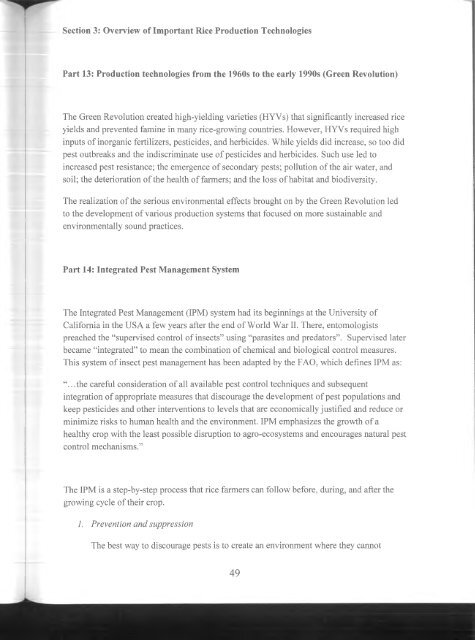Bradbrook - 2012 - Rice Farming complete with methods to increase ric
Bradbrook - 2012 - Rice Farming complete with methods to increase ric
Bradbrook - 2012 - Rice Farming complete with methods to increase ric
You also want an ePaper? Increase the reach of your titles
YUMPU automatically turns print PDFs into web optimized ePapers that Google loves.
Section 3: Overview of Important <strong>Rice</strong> Production Technologies<br />
Part 13: Production technologies from the 1960s <strong>to</strong> the early 1990s (Green Revolution)<br />
The Green Revolution created high-yielding varieties (HYVs) that significantly <strong>increase</strong>d <strong>ric</strong>e<br />
yields and prevented famine in many <strong>ric</strong>e-growing countries. However, HYVs required high<br />
inputs of inorganic fertilizers, pesticides, and herbicides. While yields did <strong>increase</strong>, so <strong>to</strong>o did<br />
pest outbreaks and the indiscriminate use of pesticides and herbicides. Such use led <strong>to</strong><br />
<strong>increase</strong>d pest resistance; the emergence of secondary pests; pollution of the air water, and<br />
soil; the deterioration of the health of farmers; and the loss of habitat and biodiversity.<br />
The realization of the serious environmental effects brought on by the Green Revolution led<br />
<strong>to</strong> the development of various production systems that focused on more sustainable and<br />
environmentally sound practices.<br />
Part 14: Integrated Pest Management System<br />
The Integrated Pest Management (IPM) system had its beginnings at the University of<br />
California in the USA a few years after the end of World War II. There, en<strong>to</strong>mologists<br />
preached the “supervised control of insects” using “parasites and preda<strong>to</strong>rs”. Supervised later<br />
became “integrated” <strong>to</strong> mean the combination of chemical and biological control measures.<br />
This system of insect pest management has been adapted by the FAO, which defines IPM as:<br />
“.. .the careful consideration of all available pest control techniques and subsequent<br />
integration of appropriate measures that discourage the development of pest populations and<br />
keep pesticides and other interventions <strong>to</strong> levels that are economically justified and reduce or<br />
minimize risks <strong>to</strong> human health and the environment. IPM emphasizes the growth of a<br />
healthy crop <strong>with</strong> the least possible disruption <strong>to</strong> agro-ecosystems and encourages natural pest<br />
control mechanisms.”<br />
The IPM is a step-by-step process that <strong>ric</strong>e farmers can follow before, during, and after the<br />
growing cycle of their crop.<br />
1. Prevention and suppression<br />
The best way <strong>to</strong> discourage pests is <strong>to</strong> create an environment where they cannot<br />
49

















